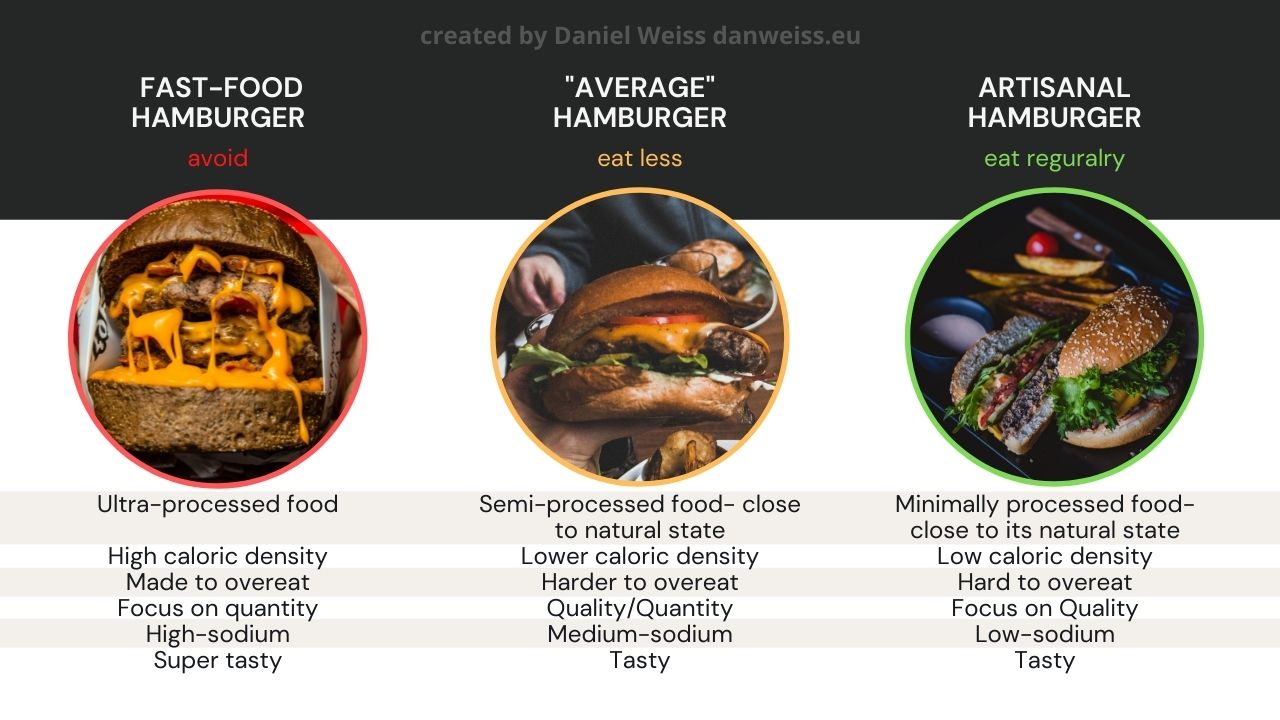What makes food healthy? Here is how to make healthy choices effectively.
“What do you think about this protein bar nutrition label and its ingredients? I heard it’s great so I bought it. The taste is 10/10 but the ingredients don’t feel quite ‘clean’ to me. I heard sunflower oil is bad, and whey should be isolate, not concentrate. I have no idea what some of the ingredients are.”
If you care about your health, you are certainly interested in the effect of various foods and the ingredients contained in them on health, weight loss, or sports performance. What usually happens is that the more you are interested in nutrition, the more information you will find, which is also often conflicting.
Is bread healthy? Are peanuts OK for a runner? Is butter healthy? Is the meat okay? What about eggs or this breakfast cereal?
How are you supposed to know? Is it necessary to carefully study the nutritional information and all the ingredients?
It is not possible to answer questions about each food separately and from every point of view. Therefore, let’s look at what is essential and what will make it easier for you to make decisions when choosing food.
The answer may be simple…
When we ask whether a food is good, healthy, or beneficial, we usually want a simple answer.
Yes, it is. – No, it’s not.
It must contain this ingredient! Avoid this at all costs!
We like simple answers because we don’t have to think about our decisions.
Is peanut butter okay for a runner? Yes, it is.
Is bread unhealthy? Yes, it is / No, it isn’t.
The answer may be as simple as:
“I like orange juice more than apple juice.”
…but also complex
However, you should also be careful about what is behind these questions. They usually come after we read an article about a certain food and its effect on health or sports performance. Claims in popular articles, and videos usually point to a new study that creates a sensation. They rarely deal with the topic comprehensively.
Therefore, if you want to know more about the impact of a certain food or its ingredient, you need to think about whether you are interested in general information – the food is rich in sodium, magnesium and contains 300kcal/100g – or you are interested in how it fits into your diet.
For most, it is important how the food fits into their diet as a whole. That’s what I do when I work with clients. We take several factors into account:
- How much of that food do you eat?
- How often?
- How does it affect you physically and mentally?
- Is it in line with your ethics and values such as ecology, health, enjoyment of food…?
- What role does it play in your life?
- What should be the purpose of including or removing this food from the menu?
- Is the price for it acceptable to you?
- Can you even get it?
- and other…
“If you want to get some sugar and vitamins out of your drink, I’d rather juice some fruits and vegetables or make a smoothie. I wouldn’t buy the juice. 100% apple juice might be fine, but I didn’t see the apples (were they nice or rotten , was there mold or not?) and the juice is too processed.”
Good or bad food?
If we want a simple answer, we categorize foods into a bad and good category. This gives us easy decision-making, but on the other hand, it does not allow us to understand a deeper connection and often even leads to unnecessary restrictions in the diet.
Dividing food into good and bad also creates a bad relationship with food, which has far-reaching consequences unless we become aware of this behavior.
Therefore, I recommend looking at food in a different way. Replace “bad” and “good” with “more appropriate” and “less appropriate”. Then also be aware that there is a whole spectrum of “suitability” between appropriate and inappropriate. You will find out that a certain food/food is suitable, more suitable, most suitable, or that you should eat it more often, less often, or rarely.

We don’t eat either-or foods
Either orange juice or beer.
Either bread or bacon.
If we decide to reduce or eliminate the intake of a certain food, what we replace it with is also important.
For example, people who decide to reduce their intake of carbohydrates in their diet in an effort to lose weight or improve their health often replace them with fat. However, this can lead to a higher intake of saturated fats and a higher total caloric intake, and worse health as a result.
“A healthy relationship with food doesn’t require you to preoccupy yourself with every little decision or have a scientific rationale for everything you choose.
In fact, once you understand the basics of how different nutrients work in the body, a healthy relationship with food can mean the exact opposite…”
John Berardi, PhD, CSCS
What to focus on if healthy food is your priority?
There are several characteristics of food that you can focus on when choosing healthy foods, especially úrpcessed products.
A food semaphore system was created to assess the nutritional value of food. You could already see it on the packaging of some foods. It looks like traffic lights marked with letters from A to F (and coloured green to red). This rating takes into account several factors such as
- fiber content
- protein content
- added sugars and fats
- the content of some nutrients
In principle, this system can be relied on, but it is not perfect. For example, food producers quickly adapted and added dietary fiber or vitamins to their products and thus “artificially” improved the score of their foods.
If healthy food is your priority, focus on:
- getting foods as close as possible to their natural form
- getting foods with less than 5 ingredients
- low cholesterol
- foods without added sugar
- local food – you will support not only your health, but also the farmers
What about sports nutrition?
Exceptions are special nutrition products (sports nutrition) or food for athletes with high energy requirements.
Highly processed carbohydrates into easily digestible sugars, or protein powders make sense, but they are not intended for regular consumption or as meal replacements!
But isn’t fruit that contains easily digestible sugars and vitamins better during sports than “artificial” energy gels?
It is true that fruits like dates are a great source of sugars and they also contain fiber and various minerals. I’ve run a lot of races on them myself. It’s also true that many energy gels have gotten a bad reputation for causing runners indigestion. This is often due to athletes not training their stomachs before the race and also trying new things during the race.
In endurance sports, however, the main problem is digestion, which is highly individual. Quickly absorbable sugars make digestion easier, you don’t have to chew them, they are easily portable and therefore ideal during sports performance.
During the marathon, we don’t see salad bars, but a lot of ionic and energy drinks and possibly melons and bananas. But no athlete at the head of the race will reach for the banana. They are more intended for hobby runners.
The goal of sports nutrition products is not health, but energy. Every athlete should pay attention to a healthy diet, but within the framework of a regular diet.
High energy requirements
Endurance and hybrid athletes often have high energy demands, and getting enough energy to support their training is often a problem.
Therefore, eating only unprocessed food, which we consider healthy, may not be healthy for such an athlete and may even lead to a deterioration of their health due to low energy availability.
For athletes, quality is in quantity.
For active athletes, not only professional but also amateur ones, it is therefore important first of all to get a sufficient amount of calories.
